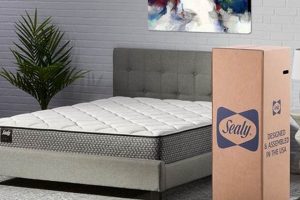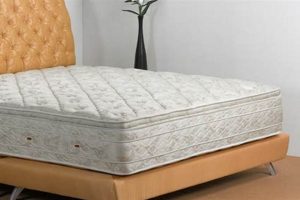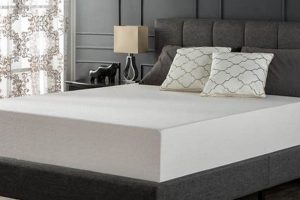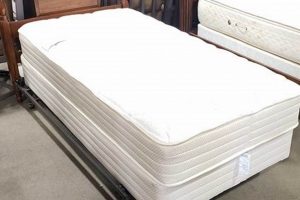The pre-compressed and rolled bedding product represents a shift in the mattress industry, offering a convenient alternative to traditional retail models. These products, typically constructed from various foam layers or hybrid combinations of foam and springs, are designed to expand to their full size and shape upon unboxing. A common example involves memory foam mattresses compressed, rolled, and sealed in plastic before being placed in a corrugated container for shipping.
The importance of this product lies in its accessibility and simplified logistics. Reduced shipping costs, direct-to-consumer sales, and ease of handling have made mattresses more affordable and convenient for consumers. Historically, purchasing a mattress involved visiting a physical store and coordinating delivery. This new product model bypassed these steps, leading to increased market competition and innovation in mattress design and materials.
The following sections will delve deeper into the construction materials, performance characteristics, and purchasing considerations associated with these bedding solutions, providing a comprehensive overview for potential buyers.
Tips for Selecting a Compressed and Packaged Bedding Product
Selecting bedding delivered in compact packaging requires careful consideration. The following tips provide guidance for ensuring a satisfactory purchase that aligns with individual sleep needs and preferences.
Tip 1: Research Material Composition: Different foam types and spring systems exhibit varying levels of support, pressure relief, and temperature regulation. Investigate the specific materials used and their respective characteristics.
Tip 2: Assess Firmness Level: Firmness is subjective, but understanding the general scale is crucial. Consider preferred sleeping position and body weight when selecting a firmness level. Side sleepers often benefit from softer options, while back and stomach sleepers may prefer firmer support.
Tip 3: Review Trial Periods and Return Policies: Most companies offer trial periods, allowing evaluation of the product at home. Scrutinize the return policy to understand associated costs and processes should the mattress prove unsuitable.
Tip 4: Investigate Off-Gassing Potential: New foam products may emit volatile organic compounds (VOCs). Research materials and manufacturing processes to minimize potential off-gassing and ensure adequate ventilation upon unboxing.
Tip 5: Consider Edge Support: Evaluate the product’s edge support, particularly if sharing the bed or frequently utilizing the edges. Strong edge support prevents sagging and maximizes usable sleep surface.
Tip 6: Evaluate Motion Isolation: If sharing the bed, consider motion isolation. Certain materials, such as memory foam, effectively minimize motion transfer, preventing disturbances from a partner’s movements.
Careful consideration of these factors can mitigate potential risks and lead to the selection of a bedding solution that promotes restful sleep and long-term satisfaction.
The subsequent section will address common misconceptions associated with these products and provide clarity on their overall quality and durability.
1. Convenience
Convenience is a central factor in the growing popularity of compressed and packaged mattresses. The direct-to-consumer business model, coupled with simplified logistics, offers a significant contrast to traditional mattress purchasing experiences.
- Simplified Purchase Process
The elimination of in-store visits streamlines the buying process. Consumers can research, select, and purchase from their homes, eliminating the need to navigate physical retail environments. This offers flexibility and saves time compared to the conventional process.
- Direct Home Delivery
These products are shipped directly to the consumer’s doorstep. This removes the need to coordinate and manage delivery from a retail store, a significant benefit for individuals with limited transportation or scheduling constraints. The process eliminates logistical barriers.
- Easy Setup
Upon arrival, these mattresses are designed for straightforward setup. The decompression and expansion process are generally uncomplicated, requiring minimal effort from the consumer. This simplicity reduces the stress and potential complications associated with traditional mattress installation.
- Reduced Time Commitment
The entire process, from initial research to final setup, requires a significantly reduced time commitment compared to traditional methods. The ability to purchase online, avoid store visits, and manage delivery independently translates to considerable time savings for the consumer.
These facets demonstrate how this purchasing option prioritizes convenience at every stage. The streamlined process, from online selection to simplified setup, represents a compelling alternative to traditional mattress purchasing experiences, aligning with contemporary consumer preferences for efficiency and ease of use.
2. Affordability
Affordability is a key driver behind the market penetration of compressed and packaged mattresses. The business model associated with these products often translates to lower prices for consumers, offering a compelling alternative to traditionally retailed mattresses.
- Reduced Overhead Costs
The direct-to-consumer model significantly reduces overhead expenses. Bypassing brick-and-mortar stores eliminates costs associated with rent, utilities, and staffing. These savings are often passed on to consumers, contributing to more competitive pricing. An example is a company that exclusively sells online and can offer lower prices than competitors with physical stores.
- Optimized Logistics and Shipping
The compression and packaging process optimizes shipping efficiency. Smaller package sizes translate to lower shipping costs, which directly impact the final price. A mattress compressed into a box is more efficiently transported than a fully expanded mattress, yielding savings that contribute to affordability.
- Simplified Inventory Management
The centralized distribution and reduced inventory holding costs associated with this model contribute to affordability. Retailers are able to more efficiently forecast demand and optimize stock levels, minimizing waste and storage expenses. This translates into cost savings that are frequently reflected in the price to the consumer.
- Competitive Market Dynamics
The rise of numerous companies offering compressed mattresses has created a competitive market landscape. This increased competition forces manufacturers to maintain competitive pricing to attract customers. The resulting price wars directly benefit consumers seeking affordable bedding solutions.
These factors collectively contribute to the affordability of mattresses sold in boxes. The reduced overhead, optimized logistics, simplified inventory management, and competitive market dynamics combine to offer consumers more accessible and cost-effective bedding options.
3. Material Composition
The material composition of a compressed and packaged mattress is fundamentally linked to its performance, durability, and suitability for individual needs. The ability to compress a mattress for shipping and subsequent expansion directly influences the materials that can be effectively utilized. Primarily, these mattresses rely on flexible materials capable of withstanding compression without permanent damage. Common materials include various types of foam (memory foam, polyurethane foam, latex foam) and, in hybrid models, pocketed coil systems designed for flexibility. The density, thickness, and specific properties of these materials directly affect the mattress’s support, pressure relief, and temperature regulation capabilities. For instance, a high-density memory foam mattress will offer greater support and contouring than one made with low-density foam. As a result, material selection is not merely a manufacturing decision but a critical factor in determining overall user satisfaction.
Different material combinations cater to diverse sleep preferences. Memory foam excels at pressure relief and motion isolation, making it suitable for individuals seeking contouring support and those who share a bed. Latex foam offers a more responsive feel, increased breathability, and natural resilience, appealing to those who prefer a bouncier surface and sleep hot. Hybrid models, combining foam layers with pocketed coils, aim to balance support, comfort, and airflow. Real-world examples include mattresses combining a base layer of high-density support foam, a comfort layer of memory foam, and a cover infused with cooling gel. These combinations address specific needs, such as spinal alignment, pressure point relief, and temperature control. Understanding the properties of each material is essential for selecting a mattress that aligns with individual sleep requirements.
In summary, material composition is a primary determinant of a compressed and packaged mattress’s overall quality and performance. The type, density, and combination of materials dictate the mattress’s support, comfort, and durability. Although compression techniques limit material choices, careful engineering allows for the creation of bedding solutions catering to a variety of sleep preferences and needs. The success of a compressed mattress relies on the strategic use of flexible materials to provide a comfortable and supportive sleep surface.
4. Direct-to-consumer
The direct-to-consumer (DTC) business model is intrinsically linked to the proliferation and success of mattresses packaged for convenient shipping. This model fundamentally alters the traditional retail landscape, impacting pricing, consumer experience, and product development.
- Elimination of Middlemen
The DTC approach removes intermediaries such as wholesalers and brick-and-mortar retailers from the sales process. By selling directly to consumers, companies can potentially reduce markups and offer products at lower prices. A mattress manufacturer operating solely through its website eliminates the profit margins typically added by traditional retailers, translating to a lower cost for the consumer.
- Enhanced Brand Control
Direct engagement with customers allows for greater control over brand messaging and customer service. DTC companies can curate the customer experience, ensuring consistent brand representation and responding directly to feedback. A mattress company using social media and email marketing to communicate directly with customers can refine its product offerings based on real-time consumer preferences.
- Data-Driven Insights
DTC sales provide access to valuable customer data, enabling targeted marketing and product development. Companies can analyze purchasing patterns and customer demographics to identify trends and tailor offerings to specific needs. A mattress company tracking online purchases and customer reviews can identify preferences for specific firmness levels or material compositions, informing future product iterations.
- Streamlined Feedback Loops
The direct interaction with consumers facilitates rapid feedback loops, enabling companies to quickly address concerns and improve products. Customer reviews, surveys, and direct communication channels provide immediate insight into product performance and areas for improvement. A mattress company promptly responding to customer concerns about off-gassing by modifying manufacturing processes exemplifies this responsive approach.
These elements underscore the symbiotic relationship between the DTC model and the mattress-in-a-box concept. By leveraging online sales and streamlined logistics, DTC mattress companies have successfully disrupted the traditional bedding industry, offering consumers greater convenience, affordability, and choice. The success of this model is contingent on maintaining strong customer relationships and adapting to evolving consumer preferences.
5. Shipping Efficiency
Shipping efficiency is a cornerstone of the “mattress that comes in a box” business model. The ability to compress and package a mattress significantly reduces its volume, impacting shipping costs and logistical complexities. This reduction in size enables more mattresses to be transported per shipment, decreasing fuel consumption and overall transportation expenses. The efficient utilization of cargo space translates directly into economic benefits for both the manufacturer and the consumer. Furthermore, a reduction in shipping volume minimizes the carbon footprint associated with transportation, aligning with environmentally conscious business practices. For example, a traditional, uncompressed mattress might require a dedicated shipment, whereas several compressed mattresses can fit within the same transport container, thereby optimizing resource utilization and decreasing the environmental impact per unit.
The optimized shipping process facilitates direct-to-consumer delivery, eliminating the need for large retail spaces and complex distribution networks. Consumers benefit from reduced shipping fees and convenient doorstep delivery, enhancing the overall purchase experience. Real-world examples of companies specializing in compressed mattresses demonstrate the practical significance of this efficiency. These companies often offer free shipping, absorbing the transport costs due to the optimized delivery process. Additionally, efficient shipping minimizes the risk of damage during transit. A smaller, more compact package is less susceptible to mishandling and reduces the likelihood of incurring damages throughout the delivery process.
In summary, shipping efficiency is integral to the viability and success of mattresses sold in boxes. The compression and packaging process drives down shipping costs, reduces environmental impact, and streamlines the delivery process. Challenges remain in maintaining product integrity during compression and ensuring proper expansion upon arrival. Nevertheless, the emphasis on shipping efficiency has revolutionized the mattress industry, providing consumers with convenient and cost-effective bedding solutions.
6. Trial Period
The trial period is an essential component of the mattress-in-a-box business model, directly addressing consumer hesitancy associated with purchasing a mattress online without prior physical interaction. This extended evaluation period allows customers to test the product in their home environment, simulating real-world sleep conditions. The cause-and-effect relationship is clear: the lack of a traditional retail experience necessitates a robust trial period to build consumer confidence. The importance of this feature cannot be overstated; it is a fundamental element that facilitates online mattress sales. Without a trial period, consumers would be significantly less likely to purchase a mattress based solely on online descriptions and reviews.
Real-life examples demonstrate the practical significance of trial periods. Many companies offer 100-night or even longer trial periods. During this time, if the customer is unsatisfied with the mattress, they can return it for a full refund. Companies like Nectar and Casper have built their reputations, in part, on offering these generous trial periods. This commitment to customer satisfaction significantly reduces the risk perceived by consumers, encouraging them to try the product. The economic impact is also noteworthy; while returns do incur costs for the companies, the increased sales volume and positive brand reputation generated by offering trial periods often outweigh these expenses. It’s a strategic investment in customer acquisition and long-term brand loyalty.
In summary, the trial period addresses the inherent challenges of selling a product as personal and tactile as a mattress online. By offering consumers an opportunity to evaluate the mattress in their own homes, companies mitigate the risk associated with online purchases. This feature has become a standard practice in the mattress-in-a-box industry, demonstrating its practical significance and its role in driving consumer adoption. The future success of this business model is, in part, contingent on maintaining and refining the trial period to meet evolving consumer expectations and ensure ongoing customer satisfaction.
Frequently Asked Questions
The following section addresses common inquiries and concerns regarding mattresses delivered in compressed packaging. These questions aim to provide clarity on various aspects, assisting potential buyers in making informed decisions.
Question 1: How long does it take for the mattress to fully expand?
Expansion time varies depending on the mattress construction and ambient temperature. Generally, a mattress will expand to its intended size within 24 to 72 hours. Full expansion may take longer in colder environments.
Question 2: Is the quality of a compressed mattress comparable to a traditional mattress?
Quality is dependent on the materials used and construction techniques, not solely on the compression method. A well-constructed compressed mattress can offer comparable or superior quality to a traditional mattress.
Question 3: What is the expected lifespan of a compressed mattress?
The lifespan is similar to that of a traditional mattress, generally ranging from seven to ten years, depending on usage, materials, and care.
Question 4: Are compressed mattresses suitable for all types of bed frames?
Most compressed mattresses are compatible with a wide range of bed frames, including platform beds, slatted frames, and adjustable bases. However, specific frame requirements should be verified prior to purchase.
Question 5: What is the off-gassing process, and is it harmful?
Off-gassing refers to the release of volatile organic compounds (VOCs) from new foam materials. While the odor may be noticeable, most mattresses meet safety standards and pose minimal health risks. Adequate ventilation is recommended during the initial expansion period.
Question 6: What are the standard warranty terms for mattresses delivered in compressed packaging?
Warranty terms vary by manufacturer, but typically cover defects in materials and workmanship. It is important to review the specific warranty details before purchasing.
Understanding these frequently asked questions can aid in evaluating the suitability of this type of mattress for individual needs and preferences.
The next section will examine long-term care and maintenance practices to ensure optimal mattress performance and longevity.
Conclusion
The exploration of “mattress that comes in a box” has revealed a significant shift in the bedding industry. This model, characterized by compressed packaging, direct-to-consumer sales, and convenient delivery, offers consumers an alternative to traditional retail methods. Key advantages include enhanced affordability, streamlined purchasing processes, and extended trial periods. However, considerations such as material composition, off-gassing potential, and long-term durability remain critical factors in the selection process. The analysis confirms the significant impact of shipping efficiency and the influence of trial periods on customer satisfaction. Understanding these interwoven factors is essential to making an informed and effective decision.
The ongoing evolution of the mattress market suggests that the popularity of compressed and packaged mattresses will persist. Consumers are encouraged to carefully weigh the presented information, factoring in individual needs and preferences, to ensure a suitable and long-lasting bedding solution. Continued innovation in materials and manufacturing processes is anticipated, potentially addressing current limitations and further enhancing the appeal of this alternative mattress category.





![Best Twin Mattress Box Spring [Deals] Sleep Better Now! Organic & Natural Mattress Buyer’s Guide: Non-Toxic Sleep Solutions Best Twin Mattress Box Spring [Deals] Sleep Better Now! | Organic & Natural Mattress Buyer’s Guide: Non-Toxic Sleep Solutions](https://mattressworldpa.com/wp-content/uploads/2025/07/th-3373-300x200.jpg)

![Best Twin Mattress Box Springs [Guide] for Support Organic & Natural Mattress Buyer’s Guide: Non-Toxic Sleep Solutions Best Twin Mattress Box Springs [Guide] for Support | Organic & Natural Mattress Buyer’s Guide: Non-Toxic Sleep Solutions](https://mattressworldpa.com/wp-content/uploads/2025/07/th-3371-300x200.jpg)